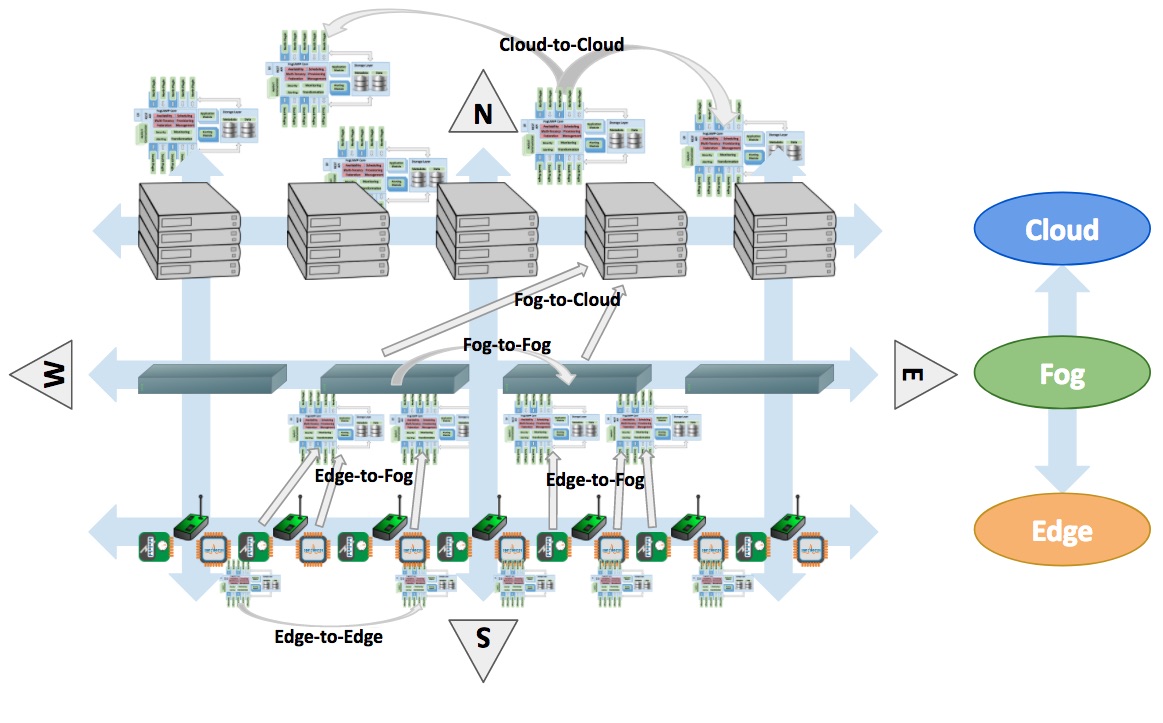Introduction¶
What Is FogLAMP?¶
FogLAMP is an open source platform for the Internet of Things and an essential component in Fog Computing. It uses a modular microservices architecture including sensor data collection, storage, processing and forwarding to historians, Enterprise systems and Cloud-based services. FogLAMP can run in highly available, stand alone, unattended environments that assume unreliable network connectivity.
By providing a modular and distributable framework under an open source Apache v2 license, FogLAMP is the best platform to manage the data infrastructure for IoT. The modules can be distributed in any layer - Edge, Fog and Cloud - and they act together to provide scalability, elasticity and resilience.
FogLAMP offers an “all-round” solution for data management, combining a bi-directional Northbound/Southbound data and metadata communication with a Eastbound/Westbound service and object distribution.
FogLAMP Positioning in an IoT and IIoT Infrastructure¶
FogLAMP can be used in IoT and IIoT infrastructure at Edge and in the Fog. It stretches bi-directionally South-North/North-South and it is distributed East-West/West-East (see figure below).

Note
In this scenario we refer to “Cloud” as the layer above the Fog. “Fog” is where historians, gateways and middle servers coexist. In practice, the Cloud may also represent internal Enterprise systems, concentrated in regional or global corporate data centers, where larger historians, Big Data and analytical systems reside.
In practical terms, this means that:
Intra-layer communication and data exchange:
At the Edge, microservices are installed on devices, sensors and actuators.
In the Fog, data is collected and aggregated in gateways and regional servers.
In the Cloud, data is distributed and analysed on multiple servers, such as Big Data Systems and Data Historians.
Inter-layer communication and data exchange:
From Edge to Fog, data is retrieved from multiple sensors and devices and it is aggregated on resilient and highly available middle servers and gateways, either in traditional Data Historians and in the new edge of Machine Learning systems.
From Fog to Edge, configuration information, metadata and other valuable data is transferred to sensors and devices.
From Fog to Cloud, the data collected and optionally transformed is transferred to more powerful distributed Cloud and Enterprise systems.
From Cloud to Fog, results of complex analysis and other valuable information are sent to the designated gateways and middle servers that will interact with the Edge.
Intra-layer service distribution:
A microservice architecture based on secure communication allows lightweight service distribution and information exchange among Edge to Edge devices.
FogLAMP provides high availability, scalability and data distribution among Fog-to-Fog systems. Due to its portability and modularity, FogLAMP can be installed on a large number of intermediate servers and gateways, as application instances, appliances, containers or virtualized environments.
Cloud to Cloud FogLAMP server capabilities provide scalability and elasticity in data storage, retrieval and analytics. The data collected at the Edge and Fog, also combined with external data, can be distributed to multiple systems within a Data Center and replicated to multiple Data Centers to guarantee local and faster access.
All these operations are scheduled, automated and executed securely, unattended and in a transactional fashion (i.e. the system can always revert to a previous state in case of failures or unexpected events).
FogLAMP Features¶
In a nutshell, these are main features of FogLAMP:
Transactional, always on, server platform designed to work unattended and with zero maintenance.
Microservice architecture with secured inter-communication:
Core System
Storage Layer
South side, sensors and device communication
North side, Cloud and Enterprise communication
Application Modules, internal application logic
Pluggable modules for:
South side: multiple, data and metadata bi-directional communication
North side: multiple, data and metadata bi-directional communication
East/West side: IN/OUT Communicator with external applications
Plus:
Data and communication authentication
Data and status monitoring and alerting
Data transformation
Data storage and retrieval
Small memory and processing footprint. FogLAMP can be installed and executed on inexpensive Edge devices; microservices can be distributed on sensors and actuator boards.
Resilient and optionally highly available.
Discoverable and cluster-based.
Based on APIs (RESTful and non-RESTful) to communicate with sensors and other devices, to interact with user applications, to manage the platform and to be integrated with a Cloud or Data Center-based data infrastructure.
Hardened with default secure communication that can be optionally relaxed.